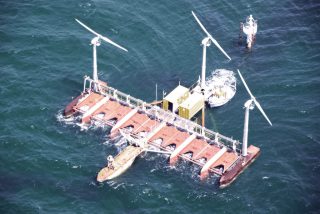From Guest Blogger Tanya Meyer: How Increasing Alternative Energy Production Affects the Valve Manufacturing Industry

Since traditional methods gradually became not only outdated but (in some cases) also harmful, we got to witness the emergence of a number of alternative power generation approaches. Governments are now trying to encourage more sustainable solutions, as the memory of the Fukushima’s nuclear disaster – one of most catastrophic occurrences this decade has seen so far – is still very much alive in our collective consciousness and lobbying for clean-tech.
A Rocky Path to Finding Balance
By now, we’ve become very much aware of global warming and its damaging effects – the time to simply formulate hypotheses is up. The action is needed and it requires that appropriate adjustments be made in order to ensure a safe, viable exploitation of new energy sources.
Take solar energy sourcing for example: even though they are presented as ‘green energy ‘sources, solar farms produce a significant amount of air toxicity. Windmills don’t exactly fit the environmental friendly profile either. Raised noise levels aside, tens (to hundreds) of thousands of birds and bats die each year as a result of interaction with the moving rotor blades. Setting up and maintaining turbines are not without consequences as building control stations and substations, transmission lines, meteorological towers, and service roads can have a long-term impact on different habitats. Not to mention the ever-present hazard of arc flashes.
Energy Gatekeepers
Producing energy is a complex endeavor, one that heavily relies on very specific equipment. The valves all energy generation technologies are currently using, represent somewhat of a gatekeeper. They are instrumental to controlling temperature and/or pressure levels, regulating the flow of materials and/or fluids and operating detailed automation systems which enable safe equipment usage.
They might not be the most critical part of a power producing plant, however, their essential operational function is undeniable. As direct contributors to how entire infrastructures run over long periods of time, valves play an important role in the mechanics of energy generation; even more so when they are placed in harsh environmental conditions.
- In a coal power plant for instance, valves are exposed to temperatures and pressure levels that surpass 1000 F and 3000 PSI. In ethanol-based energy generation processes, they bear risks related to polymer sealing materials. Static electricity can sometimes accumulate on the pipes and valves, during fluids transference, and, if the isolation is faulty, flammable liquids will easily burst into flames.
- In a solar power plant, the control valves require particular attention as this type of energy generation raises a whole new set of challenges. Since salt is the most commonly agent used for heat transference, they need to be adjusted so that crystallization may be significantly decreased. This is why special sealing systems and additional bonnets are necessary.
- For windmills, valves must be adapted to withstand and release air pressures that can rise to extreme. The air always goes to the point of least resistance, thus onshore and offshore wind turbines usually rely on servo valves, with multiple failsafe options and monitoring capabilities, to avoid system disruptions.
Glass Half Full
Changing functional routines is never easy and highly technologized environments are no exception but, that’s how progress occurs. There are undeniable advantages related to the necessity of having new valves designs and technologies.
First (and foremost): fueling industry-specific research; technological advancements cannot do without a large and multi-faceted knowledge pool. To get to the desired results considerable budgets and brainpower – meaning fully specialized professionals – need to be invested in the long run, thus stimulating niched education providers and job creation.
Secondly: when new techniques appear, the production lines need to be readjusted or changed (partially or completely) in order to adapt to the new processes. This produces a chain-reaction effect and triggers changes in how end-users deploy the new products. They might end up needing additional training on how to install, maintain and troubleshoot them. As a result, industry professionals will see their scope of practice increased and will be able to actually promote the benefits of green energy.
Conclusion
Although the need is real and opportunities are high, the challenges put forward by the switch in energy generation methods are directly proportional. As modern history shows, moving from tradition to innovation takes a lot of time and valves manufacturers need to keep up with the changes and stay ahead of the game by improving on existing technologies with new materials and solid systems.
